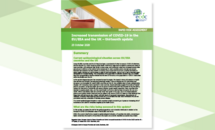Rapid Risk Assessment: Increased transmission of COVID-19 in the EU/EEA and the UK – thirteenth update
In this update, we assess the risk for the general population and vulnerable individuals in relation to the increase in COVID-19 notification rates in the EU/EEA and the UK.
Executive Summary
Current epidemiological situation across EU/EEA countries and the UK
Across the European Union/European Economic Area (EU/EEA) and the United Kingdom (UK) there has been a considerable further increase in COVID-19 infections and the current situation represents a major threat to public health. In most countries, notification rates have increased in certain regions, with extremely high levels in some areas. Moreover, in addition to the substantial increases seen in most countries among younger age groups, notification rates have also increased in older age groups. Reported test positivity has been steadily increasing since August and has shown a marked escalation in recent weeks, pointing to a real increase in rates of viral transmission, rather than just a rise in reported cases attributable to increased testing. Vulnerability to infection remains high, as available data from seroprevalence studies indicate that the level of immunity in the population is <15% in most areas of the EU/EEA and the UK.
As the epidemiological situation has worsened across the region, the impact in terms of pressure on healthcare services and mortality has become increasingly evident. Data on hospital and intensive care unit (ICU) admissions and occupancy are incomplete for most EU/EEA countries and the UK, but available data indicate that the situation is deteriorating, with increasing trends reported in most countries. Recent estimates suggest that levels of hospital and ICU occupancy across the region are now at around a third of the peak that occurred during the spring. Options for treatment of individuals with severe infection remain largely supportive. Many countries have reported increasing death rates, and the overall death notification rate has been rising for over a month. Although case fatality rates are currently lower than they were earlier in the year, due to increased detection among young people and/or improved care for patients with severe COVID-19, there is a high likelihood that these rates will continue to rise. In fact, with high levels of community transmission, the protection of medically vulnerable individuals becomes more difficult and, it is inevitable that more individuals who are not considered medically vulnerable will develop severe disease.
The current epidemiological situation in most countries is a serious concern as it poses an increasing risk of transmission, requiring immediate, targeted public health action.
What are the risks being assessed in this update?
In this update, we assess the risk for the general population and vulnerable individuals in relation to the increase in COVID-19 notification rates in the EU/EEA and the UK.
Under the current classification system, based on epidemiological indicators, the epidemiological situation in countries is classified as stable, of concern or of serious concern. The majority of countries in the region are currently classified as experiencing an epidemiological situation of serious concern due to the increasing case notification rates and/or test positivity ≥ 3% as well as the high notification rates in the older age groups and/or high mortality rates. EU/EEA countries and the UK have implemented various non-pharmaceutical interventions but these have not been sufficiently effective in controlling transmission due to several factors: adherence to the measures was sub-optimal; the measures were not implemented quickly enough; or the measures were insufficient to reduce exposure. As a result, the epidemiological situation is now rapidly deteriorating in most countries. Consequently, in countries where the epidemiological situation is of serious concern, there is a high risk to the general population, and for vulnerable individuals the COVID-19 epidemiological situation represents a very high risk.
Based on the latest available data to ECDC, there are currently no countries categorised as having an epidemiological situation ‘of concern’.
In the countries where the epidemiological situation is of serious concern, the continuously increasing trend in notification rates calls for strong public health action in order to prevent the imminent risk that healthcare systems will be overwhelmed, rendering them unable to provide safe, adequate care.
There are currently only six countries in the region that are classified as experiencing a stable epidemiological situation. In these countries the probability of infection for the population is generally low but the impact of infection still varies depending on the individuals affected. The risk for the general population in these countries is low. However, for vulnerable individuals, including the elderly and people with underlying medical conditions, the risk is moderate. Nevertheless, in these six countries, there is still ongoing transmission and the situation must be closely monitored.
Options for response
At this stage, non-pharmaceutical interventions adapted to the local epidemiological situation, accompanied by clear, targeted communication messages to the public remain the fundamental elements of the public health approach to controlling transmission. A strong call for collective action is needed whereby the population is reminded of its key role in bringing the pandemic under control. Government and public health officials urgently need to re-motivate people to follow recommendations, by making clear that there will be a substantial impact on public health, the economy and society if the epidemiological situation continues to deteriorate.
Countries should continue to implement measures to reduce transmission in the general population, such as advocating physical distancing, including the avoidance of large gatherings, promoting hand and respiratory etiquette, encouraging the appropriate use of face masks, and implementing best practices in infection prevention and control in healthcare and residential settings. Where necessary, these measures can be scaled up and countries may need to close public spaces and introduce stay-at-home recommendations as a last resort. These measures can be adopted at national or sub-national level, based on a comprehensive assessment of the local situation, using a transparent decision-making process that is clearly communicated to the public in a timely manner.
Public health authorities should reinforce healthcare capacity to manage potentially high numbers of COVID-19 patients and ensure that health services do not become overwhelmed. Efforts must be made to protect vulnerable individuals and healthcare workers, and to minimise the risk of transmission in long-term care facilities and other settings at high risk of COVID-19 outbreaks. Easy and timely access to testing is critical in order to identify infections in the community, to have a clear understanding of the evolving epidemic and to optimise the effectiveness of measures such as case isolation and contact tracing. If the number of suspected cases exceeds the available testing capacity in a country or an area, testing needs to be directed towards priority groups. Countries should also ensure that adequate supplies of medical equipment, personal protective equipment, laboratory reagents and consumables are available to prevent shortages due to the high demand worldwide.
Download
Erratum: Figure 4 has been replaced to correct errors identified in panels A, B and C. The revised figure now includes data from additional countries for week 42 in panel A as their data were excluded for that week in the original version. Panels B and C now correctly plot hospital and ICU occupancy rates per 100 000 population, rather than the numbers of inpatients in hospital and ICU that were plotted in the original version.








